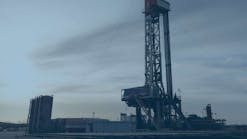Pakistan is pressing efforts to boost oil and gas production.
The country is producing 70,000 b/d of crude, enough to meet 41% of domestic demand, reported Iqbal Haidari in Economic Review, a monthly Karachi publication.
Pakistan oil reserves have shot up dramatically in recent years, to about 108.91 million bbl in 1989 from 17.1 million bbl in 1988, Haidari wrote. Oil & Gas Journal estimated Pakistan's oil reserves at 162 million bbl as of Jan. 1, 1991, up from about 118 million bbl on Jan. 1, 1990.
In addition, natural gas now meets 35% of Pakistan's energy needs with production at 1.4 bcfd, Haidari said.
Key to that effort being sustained is Pakistan's campaign to attract more foreign operators through sweetened terms and pared bureaucratic red tape.
Economic Review also reported efforts to improve the country's oil and gas infrastructure, notably refining.
Pakistan's crude and refined products import bill in fiscal 1990-91 is expected to total $1.16 billion. Almost one fourth of the country's foreign exchange earnings are spent on crude and products. In 1981, oil imports accounted for only 10% of Pakistan's foreign exchange earnings.
If present energy consumption trends continue, in 5 years Pakistan could be spending more than half its total foreign exchange earnings on crude and products imports, Economic Review said.
FOREIGN PARTICIPATION
Haidari said an area of 193,700 sq km is under exploration by 29 foreign and local companies with 42 concessions granted in 1988-90 alone.
Principal foreign operators include BP Exploration, British Gas plc, Albion International Resources Inc., Austria's state owned OMV AG, and the local subsidiaries of Texaco Inc., Amoco Corp., Occidental Petroleum Corp., and Unocal Corp.
Pakistan's main oil producing fields are Dhurnal-the biggest-Chak Naurang, Meyal, Fimkassar, Leghari, and Thara.
Chief producing gas fields are Sui, Mari, Meyal, Pirkoh, Toot, Dhurnal, Kandhkot, Golrachi, Turk, Loti, Mazari, and Matli. Most Pakistani gas fields are in southern Baluchistan province bordering Iran.
Top gas producing companies are Oxy, Pakistan Petroleum Ltd., Mari Gas Co., state owned Oil & Gas Development Corp. (OGDC), and Union Texas Pakistan Inc.
WORLD BANK LOAN
The World Bank has agreed to provide Pakistan a $90 million loan for OGDC exploration, development, and related infrastructure work.
It is expected that an additional $50 million will come from the bank through cofinancing.
The Pakistan government will contribute $20 million for the program, putting total cost at $160 million.
The World Bank program calls for development of Dhodak gas field with two development wells, installation of a gas processing plant, construction of a gas pipeline from Dhodak to Kot Addu to back out fuel oil at the power plant there, and installation of a tank farm for condensate at Dhodak.
In addition, the World Bank program will support exploration and appraisal work in nine current joint ventures for which the Pakistan government and OGDC have continuing commitments. OGDC also entered joint ventures with oil companies in Pothar Sanghar and other prospective areas.
Further, World Bank is to provide technical assistance to Pakistan's Directorate General of Petroleum Concessions and Hydrocarbon Development Institute.
SWEETENED TERMS, REFORMS
One key to the stepped up foreign presence is an amended income tax law that makes it easier to recover dry hole costs.
Haidari wrote of other government efforts to boost oil and gas activity in Pakistan that include:
- Expediting oil exploration in Baluchistan province.
- Accelerating processing and final approval of pending and new applications for exploration licenses.
- increasing refining capacity.
- Laying pipelines from Badin and Sanghar oil fields in Sind province to ensure stable, cheaper transportation.
- Implementing tertiary recovery projects in the Potwar area of northern Pakistan.
- Removing restrictions on utilization of new gas fields for power generation.
- Revising gas price policies.
- Giving OGDC more freedom in operating decisions.
REFINING IMPROVEMENTS
Pakistan's refineries are pushing to boost production and expand capacity.
Current refining capacity is 123,000 b/d at two refineries in Karachi and one in Rawalpindi. That is expected to jump to 407,000 b/d with start-up of three proposed new refineries: Pak-Arab, Pak-Iran, and Badin.
Interim plans are under way to stretch existing refining capacity by another 20,000 b/d by debottlenecking.
Pakistan's private sector has been shy to invest in refining because of the government's refusal to allow a charge for refining crude on an import parity basis.
"Inordinate delays in expanding the refining capacity in the country and dallying over the location of a new refinery in Sindh have left Pakistan short of refining capacity in the wake of the Persian Gulf crisis," Economic Review said.
Pakistan still must import about 45% of its heating oil, kerosine, and diesel fuel.
Plans to build the country's fourth refinery at Badin in Sindh are in final stages, Economic Review reported. The $200 million refinery will have an initial capacity of 35,000 b/d, to climb ultimately to 45,000 b/d, and process waxy crude from Sindh province.
FOREIGN REFINERY PROPOSALS
An earlier tripartite proposal by Iran, Libya, and Bahrain to help Pakistan build a refinery appears to have run into trouble because of last minute modifications sought by Pakistani bureaucrats, Economic Review said.
The three countries had offered to help Pakistan build a $365 million coastal refinery with a capacity of 80,000 b/d. Pakistan was to provide only the land and a small sum of money. This plant would have enabled the country to cut products imports by 80%.
Iran, which was to contribute the biggest share of investment in the project, wants to have the refinery built in Pakistan's duty free export zone.
However, the Pakistani bureaucracy tried to change the site so Pakistan could gain tax revenues from the refinery. This met strong resistance from Iran.
It is not clear what the current situation is, although there are reports Iran has agreed to build an 80,000 b/d refinery at Pakistan's Port Oasim, Economic Review said.
Copyright 1991 Oil & Gas Journal. All Rights Reserved.
